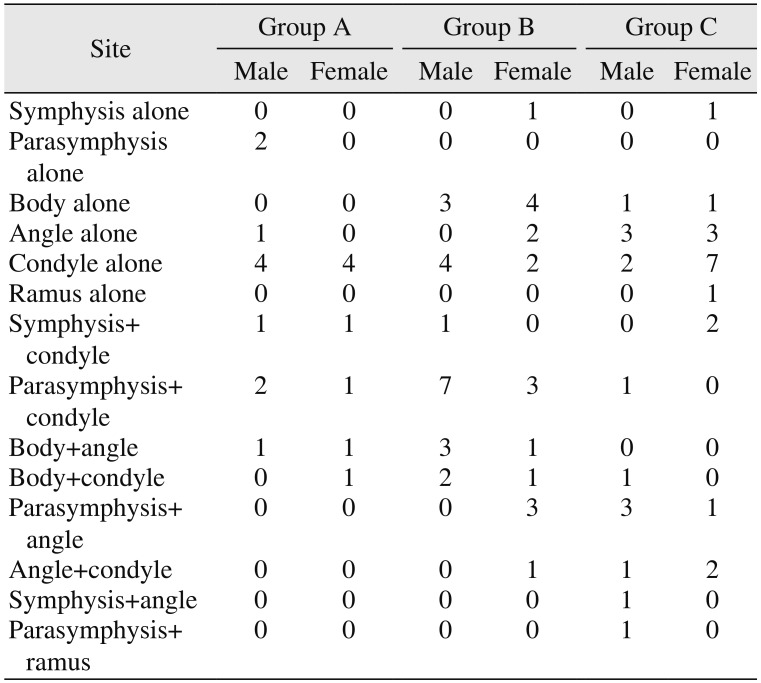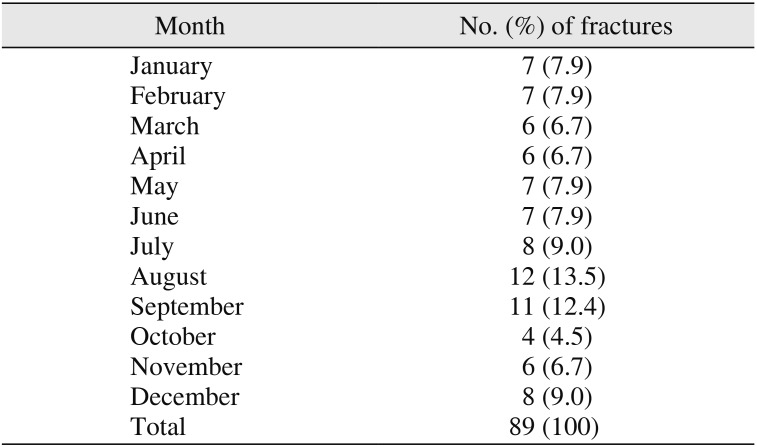1. Marano R, de Oliveira Neto P, Sakugawa KO, Zanetti LSS, de Moraes Z. Mandibular fractures in children less than 3 years: a rare case report. Rev Port Estomatol Med Dent Cir Maxilofac. 2013; 54:115–176.
2. Haug RH, Foss J. Maxillofacial injuries in pediatric patient. Oral Surg Oral Med Oral Pathol Oral Radiol Endod. 2000; 90:126–134. PMID:
10936829.
3. Almahdi HM, Higzi MA. Maxillofacial fractures among Sudanese children at Khartoum Dental Teaching Hospital. BMC Res Notes. 2016; 9:120. PMID:
26905310.

4. Muñante-Cárdenas JL, Olate S, Asprino L, de Albergaria Barbosa JR, de Moraes M, Moreira RW. Pattern and treatment of facial trauma in pediatric and adolescent patients. J Craniofac Surg. 2011; 22:1251–1255. PMID:
21772206.

5. Collao-González C, Carrasco-Labra A, Sung-Hsieh HH, Cortés-Araya J. Epidemiology of pediatric facial trauma in Chile: a retrospective study of 7,617 cases in 3 years. Med Oral Patol Oral Cir Bucal. 2014; 19:e99–e105. PMID:
23986019.
6. Pandey S, Roychoudhury A, Bhutia O, Singhal M, Sagar S, Pandey RM. Study of the pattern of maxillofacial fractures seen at a tertiary care hospital in North India. J Maxillofac Oral Surg. 2015; 14:32–39.

7. Singhal R, Singh V, Bhagol A, Agrawal A, Kumar P. Pediatric maxillofacial injuries - if a new look is required? Int J Pediatr Otorhinolaryngol. 2013; 77:1333–1336. PMID:
23800474.

8. Joshi SR, Saluja H, Pendyala GS, Chaudhari S, Mahindra U, Kini Y. Pattern and prevalence of maxillofacial fractures in rural children of central Maharashtra, India. A retrospective study. J Maxillofac Oral Surg. 2013; 12:307–311. PMID:
24431857.

9. Kumar GB, Dhupar V, Akkara F, Kumar SP. Patterns of maxillofacial fractures in goa. J Maxillofac Oral Surg. 2015; 14:138–141.

10. Gassner R, Tuli T, Hächl O, Rudisch A, Ulmer H. Cranio-maxillofacal trauma: a 10 year review of 9,543 cases with 21,067 injuries. J Craniomaxillofac Surg. 2003; 31:51–61. PMID:
12553928.
11. Abdullah WA, Al-Mutairi K, Al-Ali Y, Al-Soghier A, Al-Shnwani A. Patterns and etiology of maxillofacial fractures in Riyadh city, Saudi Arabia. Saudi Dent J. 2013; 25:33–38. PMID:
23960553.

12. Ferreira P, Marques M, Pinho C, Rodrigues J, Reis J, Amarante J. Midfacial fractures in children and adolescents: a review of 492 cases. Br J Oral Maxillofac Surg. 2004; 42:501–505. PMID:
15544878.

13. Verma S, Chambers I. Update on patterns of mandibular fracture in Tasmania, Australia. Br J Oral Maxillofac Surg. 2015; 53:74–77. PMID:
25453253.

14. Killey HC. Killey's fractures. In : Banks P, editor. Killey's fractures of the mandible. 3rd ed. London: Wright;1988. p. 15–28.
15. Cole P, Kaufman Y, Hollier LH Jr. Managing the pediatric facial fracture. Craniomaxillofac Trauma Reconstr. 2009; 2:77–83. PMID:
22110800.

16. Namdev R, Jindal A, Bhargava S, Dutta S, Singhal P, Grewal P. Patterns of mandible fracture in children under 12 years in a district trauma center in India. Dent Traumatol. 2016; 32:32–36. PMID:
26149608.
17. Owusu JA, Bellile E, Moyer JS, Sidman JD. Patterns of pediatric mandible fractures in the United States. JAMA Facial Plast Surg. 2016; 18:37–41. PMID:
26470008.

18. Kumaraswamy SV, Madan N, Keerthi R, Singh DS. Pediatric injuries in maxillofacial trauma: a 5 year study. J Maxillofac Oral Surg. 2009; 8:150–153. PMID:
23139495.

19. Atilgan S, Erol B, Yaman F, Yilmaz N, Ucan MC. Mandibular fractures: a comparative analysis between young and adult patients in the southeast region of Turkey. J Appl Oral Sci. 2010; 18:17–22. PMID:
20379677.

20. Holland AJ, Broome C, Steinberg A, Cass DT. Facial fractures in children. Pediatr Emerg Care. 2001; 17:157–160. PMID:
11437137.

21. Muraoka M, Nakai Y, Nakagawa K, Yoshioka N, Nakaki Y, Yabe T, et al. Fifteen-year statistics and observation of facial bone fracture. Osaka City Med J. 1995; 41:49–61. PMID:
8778646.
22. Schlievert R. Infant mandibular fractures: are you considering child abuse? Pediatr Emerg Care. 2006; 22:181–183. PMID:
16628104.
23. Knoche JW, LeBlanc KK, King TW, Knox BL. An infant with a unilateral mandibular fracture: when to consider nonaccidental trauma. Clin Pediatr (Phila). 2012; 51:404–407. PMID:
22456490.
24. Fasola AO, Obiechina AE, Arotiba JT. Fractures of the mandible in children. East Afr Med J. 2001; 78:616–618. PMID:
12219970.

25. Tanaka N, Uchide N, Suzuki K, Tashiro T, Tomitsuka K, Kimijima Y, et al. Maxillofacial fractures in children. J Craniomaxillofac Surg. 1993; 21:289–293. PMID:
8263213.

26. Bamjee Y. Paediatric maxillofacial trauma. J Dent Assoc S Afr. 1996; 51:750–753. PMID:
9462032.
27. Shi J, Chen Z, Xu B. Causes and treatment of mandibular and condylar fractures in children and adolescents: a review of 104 cases. JAMA Otolaryngol Head Neck Surg. 2014; 140:203–207. PMID:
24408746.
28. Thorén H, Iso-Kungas P, Iizuka T, Lindqvist C, Törnwall J. Changing trends in causes and patterns of facial fractures in children. Oral Surg Oral Med Oral Pathol Oral Radiol Endod. 2009; 107:318–324. PMID:
18964157.

29. Jung HW, Lee BS, Kwon YD, Choi BJ, Lee JW, Lee HW, et al. Retrospective clinical study of mandible fractures. J Korean Assoc Oral Maxillofac Surg. 2014; 40:21–26. PMID:
24627839.

30. Posnick JC, Wells M, Pron GE. Pediatric facial fractures: evolving patterns of treatment. J Oral Maxillofac Surg. 1993; 51:836–844. discussion 844-5. PMID:
8336220.

31. Burlini D, Conti G, Amadori F, Bardellini E, De Giuli C. Management of paediatric maxillofacial fractures: conventional methods and resorbable materials. Eur J Paediatr Dent. 2015; 16:24–28. PMID:
25793949.






 PDF
PDF ePub
ePub Citation
Citation Print
Print





 XML Download
XML Download